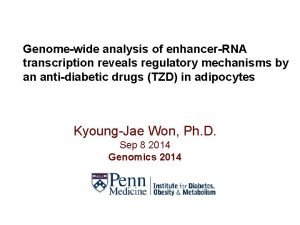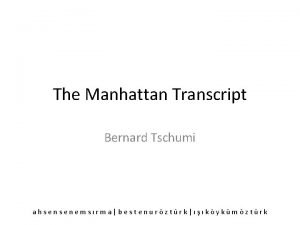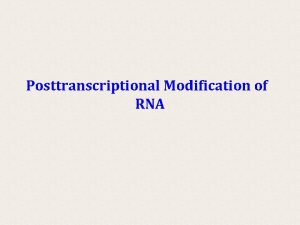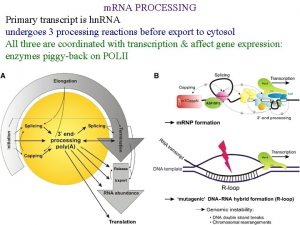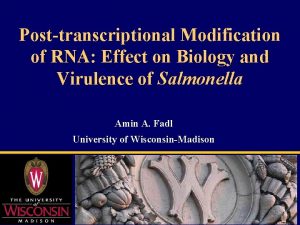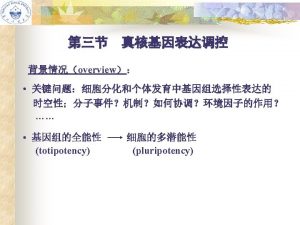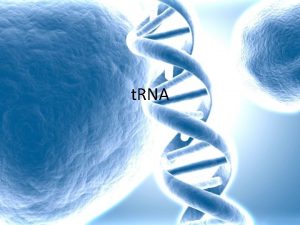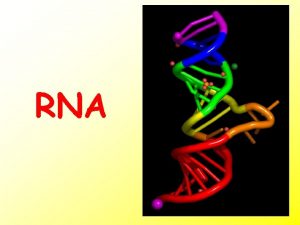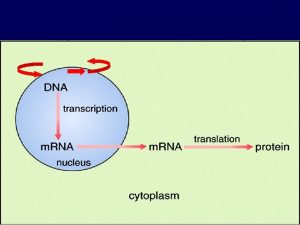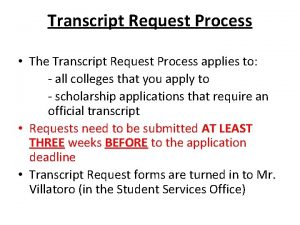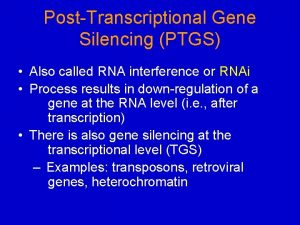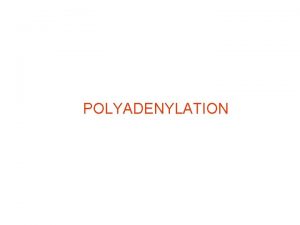Posttranscriptional Modification of RNA A primary transcript is












- Slides: 12

Posttranscriptional Modification of RNA

ü A primary transcript is the initial, linear, RNA copy of a transcription unit—the segment of DNA between specific initiation and termination sequences. ü The primary transcripts of both prokaryotic and eukaryotic t. RNA and r. RNA are posttranscriptionally modified by cleavage of the original transcripts by ribonucleases. ü t. RNAs are then further modified to help give each species its unique identity. ü In contrast, prokaryotic m. RNA is generally identical to its primary transcript, whereas eukaryotic m. RNA is extensively modified both co- and posttranscriptionally.

A. Ribosomal RNA o o o r. RNAs of both prokaryotic and eukaryotic cells are generated from long precursor molecules called pre-r. RNAs. The 23 S, 16 S, and 5 S r. RNA of prokaryotes are produced from a single pre-r. RNA molecule, as are the 28 S, 18 S, and 5. 8 S r. RNA of eukaryotes. The pre-r. RNAs are cleaved by ribonucleases to yield intermediatesized pieces of r. RNA, which are further processed (trimmed by exonucleases and modified at some bases and riboses) to produce the required RNA species. Posttranscriptional processing of eukaryotic ribosomal RNA by ribonucleases (RNases).

B. Transfer RNA A. Primary t. RNA transcript. B. Functional t. RNA after posttranscriptional modification. Modified bases include D (dihydrouracil), ψ (pseudouracil), and m, which means that the base has been methylated.

o o Both eukaryotic and prokaryotic t. RNA are also made from longer precursor molecules that must be modified. Sequences at both ends of the molecule are removed and, if present, an intron is removed from the anticodon loop by nucleases.

C. Eukaryotic m. RNA ü The collection of all the primary transcripts synthesized in the nucleus by RNA polymerase II is known as heterogeneous nuclear RNA (hn. RNA). ü The pre-m. RNA components of hn. RNA undergo extensive co- and posttranscriptional modification in the nucleus. ü These modifications usually include: 1. 5’- Capping: 7 -Methyl-guanosine 2. 3’- Poly-A tail addition 3. Removal of introns 4. Alternative splicing of m. RNA molecules

1. 5’- Capping: 7 -Methyl-guanosine o. The cap is a 7 -methylguanosine attached “backward” to the 5'-terminal end of the m. RNA, forming an unusual 5'→ 5' triphosphate linkage. o. Creation of the cap requires removal of the γ phosphate from the 5’-triphosphate of the prem. RNA, followed by addition of GMP (from GTP) by the nuclear enzyme guanylyltransferase. o. Methylation of this terminal guanine occurs in the cytosol, cytosol and is catalyzed by guanine-7 methyltransferase. S-adenosylmethionine is the source of the methyl group Additional methylation steps may occur. o. The addition of this 7 -methylguanosine “cap” helps stabilize the m. RNA, and permits initiation of translation. o. Eukaryotic m. RNAs lacking the cap are not efficiently translated.

2. 3’- Poly-A tail addition ü Most eukaryotic m. RNA have a chain of 40– 200 adenine nucleotides attached to the 3'-end. ü This poly-A tail is not transcribed from the DNA, but rather is added after transcription by the nuclear enzyme, polyadenylate polymerase, using ATP as the substrate. ü The m. RNA is cleaved downstream of a consensus sequence, called the polyadenylation signal sequence (AAUAAA), found near the 3'-end of the RNA, and the poly-A tail is added to the new 3'-end. ü These tails help stabilize the m. RNA, facilitate its exit from the nucleus, and aid in translation. After the m. RNA enters the cytosol, the poly-A tail is gradually shortened.

3. Removal of introns ü Maturation of eukaryotic m. RNA usually involves the removal of RNA sequences (introns, or intervening sequences), which do not code for protein from the primary transcript. ü The remaining coding sequences, the exons, are joined together to form the mature m. RNA. ü The process of removing introns and joining exons is called splicing. ü The molecular complex that accomplishes these tasks is known as the spliceosome. A few eukaryotic primary transcripts contain no introns, for example, ü those from histone genes. ü Others contain a few introns, whereas some, such as the primary transcripts for the α chains of collagen, contain more than 50 intervening sequences that must be removed before mature m. RNA is ready for translation.

Splicing. sn. RNP = small nuclear ribonucleoprotein particle.

4. Alternative splicing of m. RNA molecules ü The pre-m. RNA molecules from some genes can be spliced in alternative ways in different tissues. ü This produces multiple variations of the m. RNA and, therefore, of its protein product. ü This appears to be a mechanism for producing a diverse set of proteins from a limited set of genes. ü Alternative splicing: A diverse set of proteins from a small set of genes

Ø Posttranscriptionally modified by cleavage of the original transcripts by ribonucleases. Ø r. RNA of both prokaryotic and eukaryotic cells are synthesized from long precursor molecules called preribosomal RNA. Ø These precursors are cleaved and trimmed by ribonucleases, producing the three largest r. RNA, and bases and sugars are modified. Ø Eukaryotic 5 S r. RNA is synthesized by RNA polymerase III , and is modified separately. Ø Prokaryotic m. RNA is generally identical to its primary transcript, whereas eukaryotic m. RNA is extensively modified co- and posttranscriptionally. Ø Most eukaryotic m. RNAs also contain intervening sequences (introns) that must be removed to make the m. RNA functional. Ø Their removal, as well as the joining of expressed sequences (exons), requires a spliceosome composed of small, nuclear ribonucleoprotein particles that mediate the process of splicing. Ø Eukaryotic m. RNA is monocistronic, containing information from just one gene. Prokaryotic and eukaryotic t. RNA are also made from longer precursor molecules. Ø If present, an intron is removed by nucleases, and both ends of the molecule are trimmed by ribonucleases. A 3'-CCA sequence is added, and bases at specific positions are modified, producing “unusual” bases.








